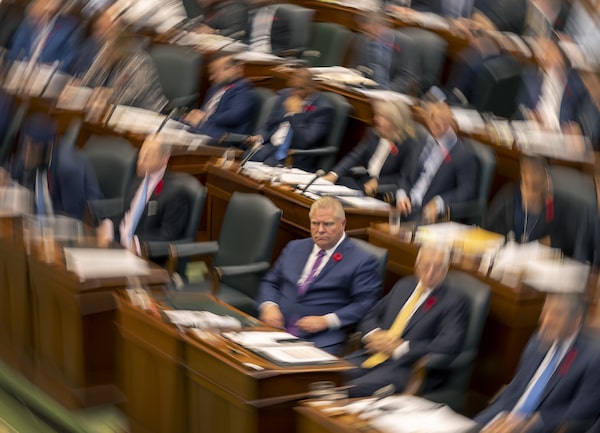
Ontario Premier Doug Ford sits in the Ontario Legislature during Question Period on Nov. 1.Frank Gunn/The Canadian Press
Benjamin Dachis is associate vice-president of public affairs at the C.D. Howe Institute. From 2018 to 2019, he worked in the Ontario Premier’s Office and helped develop the Ontario government’s Housing Supply Action Plan and related legislative and regulatory changes.
On Oct. 25, Ontario’s Ford government announced its More Homes Built Faster Act, which would allow the province to rewrite municipal plans, with the aim of allowing more land for development.
These and many more recent changes have been controversial. And more such plans are expected. Premier Doug Ford has been accused of trampling upon democracy and the environment.
But the bottom line is that Mr. Ford’s plans are going to have a substantial beneficial effect on prices for home buyers. Amid a housing crisis, this is what really matters, and Mr. Ford’s moves are necessary because, otherwise, Ontario cities won’t build up and out as much as needed on their own accord.
Some of the biggest changes in the act and changes yet to come deal with how the province sets rules on how cities plan to grow up and out. These changes are not yet law, but they will affect future planning by cities.
For a preview of what is to come, the province has already started to flex its muscle, using existing powers for changing specific zoning plans of cities.
Here’s the key background. The province sets targets for how much cities in the Greater Golden Horseshoe Area must grow. Cities must submit their plans to the province for meeting these targets. The province can then approve or amend the city plans. This has resulted in a quite a few battlegrounds between different levels of government.
In the summer, the City of Hamilton submitted its proposed plan to the province. However, the plan proposed the urban boundary would not grow outward beyond the point of the last home on the last street where people reside. The municipal government’s own staff deemed this plan inconsistent with provincial growth targets. To nobody’s surprise, on Nov. 4, the province changed Hamilton’s plan. Now, Hamilton must allow some urban expansion.
This is the right approach. Every local homeowner has a financial incentive to have fewer competing homes on the market. Each new home built puts downward pressure on the value of some incumbent homeowner’s property. So, there will usually be someone out to stop new building.
When enough existing residents of a city want that, local councillors respond and seek to reject new construction. If enough cities do that, the cumulative effect is that cities do not collectively provide enough housing to meet growth demands. So, the province is justified in asking Hamilton to grow past its existing urban boundaries.
With the More Homes Built Faster Act, the province will likely take an even more active approach in pushing more development upon municipalities. And that is a good thing.
The actions by the province in Hamilton are likely to help home buyers. Hamilton had uniquely large zoning restraints on growth that drove up home prices. A 2018 study I authored estimated that if Hamilton had the same share of its land available for housing as the average Ontario city, a single detached house would cost 20 per cent less.
Half the price difference is because of the large share of Hamilton’s land that is covered by the Greenbelt – a protected area on which the province’s current bid to build homes faces fierce opposition.
The other half of the price difference is because of unique restrictions to developing non-Greenbelt land currently zoned for agriculture. As it is now, about half of all of Hamilton’s land is zoned for agriculture. That is the highest share of land dedicated to agriculture of any municipal government in the Greater Golden Horseshoe Area.
The province’s Nov. 4 order had 4 per cent of Hamilton’s agricultural land zoned for housing: 2,200 hectares out of over 53,000 hectares. That removes only one-quarter of the gap in land share dedicated to agriculture compared to the average Greater Golden Horseshoe Area city. But even that incremental change can have a large price effect.
Prorating my 2018 estimates in savings for opening development on only non-Greenbelt land in Hamilton, the province’s plans would save home buyers 2.4 per cent. What would the savings be at today’s prices? Single-family homes in Hamilton should be $20,000 more affordable just from this move. That’s without touching Greenbelt land.
The Ford government’s act is a good start. But the province should not stop at pushing for more housing growing outward from cities.
It should also ask for more building up in places such as Toronto, where the province has yet to announce its view on the plans the city submitted. The province should aggressively seek to increase density. The same politics of local opposition to more housing will play out there as well, with Toronto not planning for enough homes to satisfy needed growth.
There are future battles to come between the province and cities. But they must be fought. For Ontario to meet ambitious home building targets, provincial action is needed.